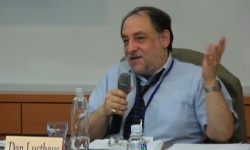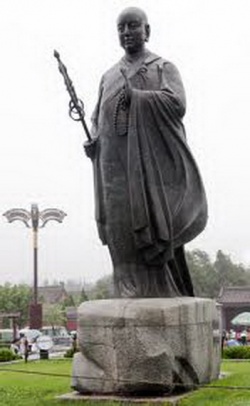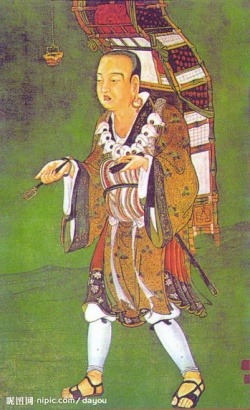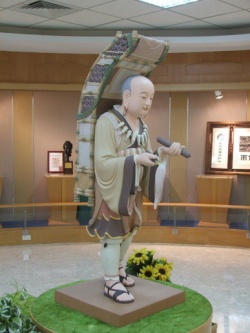Quick Overview of the Faxiang School 法相宗
By Dan Lusthaus
(Based on Lusthaus' article "Faxiang" in the Encyclopedia of Buddhism, eds. Robert Buswell, John Strong, et al., Macmillan, forthcoming. This essay is copyrighted. Do not cite without expressed permission.)
Called the Weishi 唯識 (Sanskrit, Vijñaptimātra; consciousness-only) school by its Chinese proponents, and the Faxiang 法相 (dharma characteristics) school by its opponents, this was the third major introduction of Yogācāra Buddhism into China. Competing versions of Yogācāra had dominated Chinese Buddhism since the beginning of the sixth century, first with the Northern and Southern Dilun 地論schools, which followed, respectively, the opposing interpretations by Bodhiruci 菩提流支and Ratnamati 勒那摩提 of the Dilun (Vasubandhu's commentary on the Shidi jing 十地經 [Sanskrit, Daśabhūmika-sūtra] called Daśabhūmika-sūtra-śāstra [Chinese, Shidi jing lun 十地經論], T.26.1522). Thereafter, a different brand of Yogācāra was introduced by the translator Paramārtha 真諦 (499-569) in the mid-sixth century. Disputes between these three schools (the two Dilun schools and Paramārtha's school), as well as various hybrids of Yogācāra and tathāgatagarbha thought, had become so pervasive by the time of Xuanzang 玄奘 (ca. 600-664) that he traveled to India in 629 believing that texts as yet unavailable in China would settle the discrepancies. Instead he found that the Indian understanding of Yogācāra differed in many fundamentals-doctrinally and methodologically-from what had developed in China, and on his return to China in 645 he attempted to narrow the differences by translating over seventy texts and introducing Buddhist logic.
Because the novel teachings Xuanzang conveyed represented Indian Buddhist orthodoxy and because the Chinese emperor lavished extravagant patronage on him, Xuanzang quickly became the preeminent East Asian Buddhist of his generation, attracting students from Korea and Japan, as well as China. Two of his disciples, the Korean monk Wŏnch'ŭk 圓測 (613-696) and the Chinese monk Kuiji 窺基 (632-682), bitterly competed to succeed Xuanzang upon his death, their rivalry largely centering on divergent interpretations of the Cheng weishi lun 成唯識論 (Treatise on Establishing Consciousness-Only), a commentary on Vasubandhu's Triṃśikā (Thirty Verses) that, according to tradition, Kuiji helped Xuanzang compile and translate from ten Sanskrit commentaries. Kuiji is considered by tradition to be the first patriarch of the Weishi (or Faxiang) school.
Kuiji wrote many commentaries, such as on:
the Vimalakīrtinirdeśa-sūtra ( 說無垢稱經疏, T.38.1782)
the Heart Sūtra ( 般若波羅蜜多心經幽贊, T.33.1710 - English translation by Heng-ching Shih and Dan Lusthaus, A Comprehensive Commentary on the Heart Sutra, Numata Center, Berkeley, 2001),
the Diamond Sūtra (T.33.1700 and T.40.1816),
the Lotus Sūtra (Saddharmapuṇḍarīka-sūtra)( 妙法蓮華經玄贊, T.34.1723),
Amitābha and Maitreya Sūtras (T.37.1757; T.37.1758; T.38.1772),
And on various Yogācāra texts, such as:
the Madhyāntavibhāga ( 辯中邊論述記, T.44.1835),
the Yogācārabhūmi ( 瑜伽師地論略纂, T.43.1829),
Vasubandhu's Twenty Verses (Viṃśatikā) ( 唯識二十論述記, T.43.1834),
Vasubandhu's One Hundred Dharmas Treatise ( 大乘百法明門論解, T.44.1836),
Sthiramati's Commentary on Asaṅga's Abhidharmasamuccaya ( 雜集論述記, ZZ.74.603),
and on Buddhist logic ( 因明入正理論疏, T.44.1840);
but his commentaries on the Cheng weishi lun1 and an original treatise on Yogācāra, Fayuan yilin chang 大乘法苑義林章 (Essays on the Forest of Meanings in the Mahāyāna Dharma Garden, T.45.1861), became the cornerstones of the Weishi school.
Hui Zhao 惠沼 (650-714), the second patriarch, and Zhi Zhou 智周 (668-723), the third patriarch, wrote commentaries on the Fayuan yulin chang, the Lotus Sūtra, and the Madhyāntavibhāga; they also wrote treatises on Buddhist logic and commentaries on the Cheng weishi lun.2 After Zhi Zhou, Faxiang's influence declined in China, though its texts continued to be studied by other schools. In the late nineteenth and early twentieth centuries Faxiang enjoyed a revival among Chinese philosophers such as Yang Wenhui (1837-1911), Ouyang Jingwu (1871-1943), Taixu (1890-1947), and Xiong Shili (1883-1968), who sought a bridge between native philosophy and Western philosophy, especially in the field of epistemology.
Faxiang (Korean: Pŏpsang; Japanese: Hossō) was influential in Korea during the Unified Silla (668-935) and Koryŏ dynasties (935-1392), but faded with the decline of Buddhism in the Chosŏn dynasty (1392-1910). Similarly, Hossō, initially transmitted to Japan from China and Korea, was prominent during the Nara period (710-784), but withered under attack in the Heian period (794-1185) from rival Tendai and Shingon schools. The Hossō monk Ryōhen 良逼 (1194-1252) rebutted those attacks in his Kanjin Kakumushō 觀心覺夢鈔 (Précis on Contemplating the Mind and Awakening from the Dream), but Hossō, though surviving, declined nonetheless.
Most East Asian Buddhist schools, along with Faxiang, accepted many standard Yogācāra doctrines, such as the eight consciousnesses, three natures, and mind-only, though each school quibbled about specifics. The two doctrines that drew the most attacks were the Faxiang rejection of tathāgatagarbha ideology for being too metaphysically substantialistic and the Faxiang doctrine of five seed-families (Sanskrit, pañcagotras; Chinese, wu xing 五姓), which held that one's potential for awakening was determined by the good seeds already in one's consciousness stream. Practitioners of the Hīnayāna, pratyekabuddha, and Mahāyāna paths, as well as those who were undecided about practice, could fulfill these paths only by bringing the respective seeds of whichever path they contained to fruition. A fifth seed-family, icchantika, being devoid of the requisite seeds, can never and would never desire to achieve awakening. Since the other East Asian Buddhist schools held that all beings possess buddha-nature incipiently as tathāgatagarbha, and thus all have the potential for awakening, they found the icchantika doctrine unacceptable. However, Faxiang did not treat the icchantika as an ontological category or predestination theory; it only referred to someone incorrigible, someone who, in recent lives, remains impervious to the teachings of Buddhism. Anyone desiring enlightenment, by definition, cannot be an icchantika.
Bibliography
Lusthaus, Dan. Buddhist Phenomenology: A Philosophical Investigation of Yogācāra Buddhism and the Ch'eng Wei-shih Lun.. London: RoutledgeCurzon, 2002.
Sponberg, Alan. "The Vijñaptimātratā Buddhism of the Chinese Monk K'uei-chi (A.D. 632-682)." Ph.D. dissertation, University of British Columbia, Vancouver: 1979.
Weinstein, Stanley. "The Kanjin Kakumushō." Ph.D. diss, Harvard University, 1965.
Notes
1. 成唯識論述記, T.43.1830; 成唯識論掌中樞要, T.43.1831; 成唯識論料簡, ZZ.76.927; and the partially extant 成唯識論別抄, ZZ.77.866.[back]
2. Hui Zhao's extant work, 成唯識論了義燈 (T.43.1832), a commentary on the Cheng Weishi lun (CWSL), offers details on the feud between Kuiji and Wŏnch'ŭk over interpretation of the CWSL and the right to succeed Xuanzang. Zhi Zhao's extant writings include:
成唯識論演祕, T.43.1833 (Commentary on the CWSL)
大乘入道次第, T.45.1864 (Introduction to the Mahāyāna Path)
法華經玄贊攝釋, ZZ.53.35 (Lotus Sūtra commentary)



